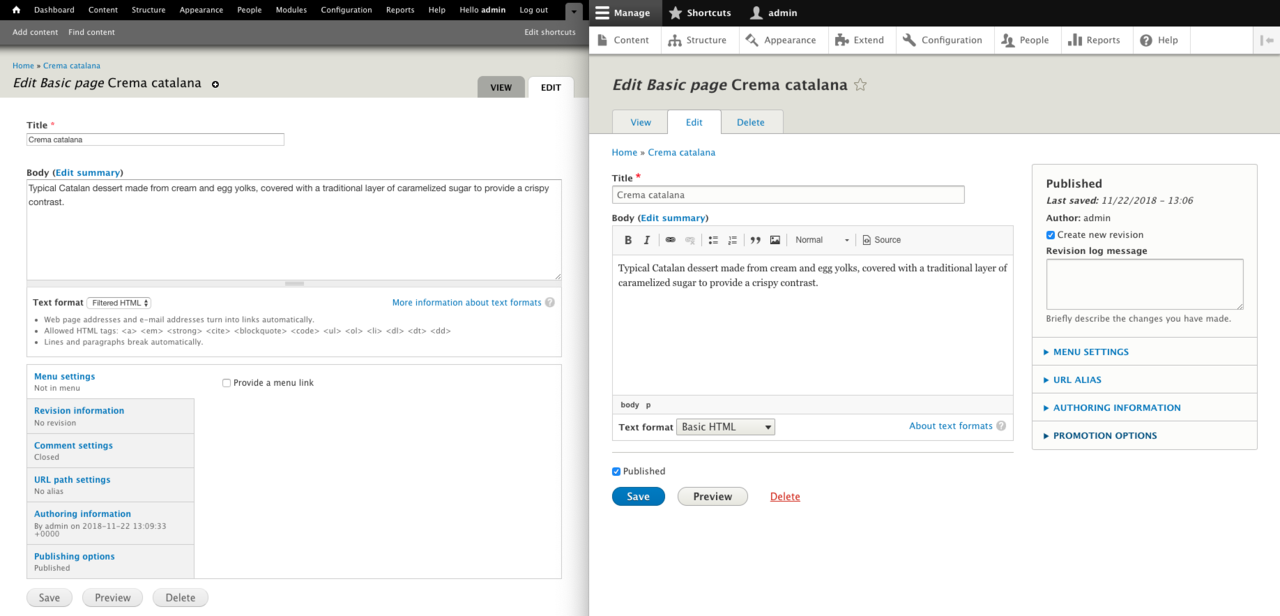Google produces about 3.5 billion searches per day, but only the top 3 search results get 55% of clicks. Which is why there is hustle to create and publish content at scale. But content creation could be tedious if done without the right CMS.
As Drupal evolves, it not only delivers ambitious digital experiences, but also consistently improves the content creation experience for its users - primarily editors and marketers.
Here’s a look at how Drupal is enabling great content authoring experiences:
Content Authoring Types
Content goes beyond just text. While blogging is extremely effective, online content can take lots of different forms: from case studies to ebooks, infographics, images, and video clips. Each comes with its own benefits.
Drupal 8 provides four out-of-the-box content types and an option to create a custom content type to suit your content marketing arsenal. It has been leading the market with the best editorial experience, chosen by organizations like Tesla, The Economist, Syfy.com, or United Nations to manage their large amount of content.

Drupal 7 interface vs Drupal 8
Empowered Editors
Drupal 8 came with some major changes in the admin and editorial interface when compared with its predecessor. The focus was clearly on improving Drupal 8 around the out-of-the-box experience for those who use Drupal websites every day. Did you guess it was authors, editors, and marketer?
-
Ease of use: As mentioned above, the aim of improving the Drupal interface was to make it intuitive and user-friendly for content creation, workflow, and publishing. Allowing you to create and manage custom content types, the editorial workflows also let you view the stage your content is in - from creation to review to publication.
-
Easy edit: Once you are aware of the stage the content is in, you can edit it from whichever device you are working on. Drupal 8 lets you review, edit and approve content from mobile devices, like iPhones, iPads and Android devices. This helps content creators to keep content and campaigns flowing, regardless of where they are and what device they’re on.
-
Editorial workflow and history: With easier editing process, it is also important to track the changes that have been made. Having a team of content editors might lead to a dilemma as to who reviewed and altered the website content. Drupal allows you to track all your history including who revised the content, when did they do so, and what - all out-of-the-box.
-
Content staging: Media and publishing, or content intensive websites need to move the content between different environments to create, review, edit and publish. Drupal 8’s Deploy module allows users to easily stage and preview content for a Drupal site in different environments. It also allows cross-site and single-site content staging.
-
Structured content: Good content needs to be seen. Google loves structured content to identify the purpose and scope of it. With schema, integral to Drupal 8, your content is Google friendly. Other structuring features such as tags, metadata, taxonomy, help your content to be reused for consumption. Content tagging and taxonomy is the mainstay of Drupal.
Empowering Editors with Acquia Lightning
With a set of pre-selected collection of modules, themes, libraries and out of the box configuration, Acquia Lightning helps content intensive websites expedite their work. At its core, Lightning contains modules for APIs, Workflow, Media, and Layout.
Acquia Lightning is a Drupal distribution to configure and manage workflows that streamline the processes for reviewing, approving, scheduling, and publishing content. Further, it comes with compatible module selection in key areas, empowering developers and site builders to rapidly create sites and applications.
Simplified Admin Interface
Content creation isn’t limited to adding blogs and other content types. The overall admin interface needs to be user friendly. Here’s how Drupal helps:
-
A simple and responsive UI: Drupal 8 is meant to be less complicated for non-technical users. The interface is consistent with buttons, radio boxes, select list, navigation, local actions, tabs, field set, listing, tables among others. These features make the interface user-friendly and help content editors streamline their work.
-
Authoring Tool Accessibility Guidelines (ATAG) 2.0 compliant: When it comes to accessibility, Drupal isn’t far behind. Drupal 8 is ATAG compliant and provides guidelines for designing web content authoring tools that are both more accessible to authors with disabilities. It enables, supports, and promotes the production of more accessible web content by all authors.
-
User permission: Providing permissions to all users can prove to be disastrous. Roles and access can be set up by the admin which cannot be undone by others. Drupal’s user permission keeps the team hierarchy onsite as well. Restricting access to admin UI would restrict the chances of onsite accidents.
-
CKEditor: A smart WYSIWYG HTML text editor, CKEditor is one of the most popular and easy to use editors. Great for content creators, Drupal 8 comes with out of the box CKEditor. It gives the content authors control over the text style, adding images or creating bullet points without the knowledge of HTML or CSS.
Without risking the content, it gives basic and restricted version as per the convenience of the user. It also warns the editor of the changes before saving. - Adding multimedia content: Content with visuals is preferred 94% times and therefore becomes a necessity for the blogs. With the media embed module, you can add images, gifs, and videos to the content. The video embed module also lets you add YouTube videos with just the link.
Drupal Modules for the Editors
-
Quick Edit: Minor errors must not take a fleet of developers to fix. Part of the core, Quick Edit allows content to be edited in-place. The module is a backport of Drupal 8’s in-place editing for Fields.
-
Pathauto: It automatically generates URL/path aliases for the nodes, taxonomy, terms, or users without manually specifying the path alias. Pathauto helps in creating SEO and user-friendly content with canonical URL structure.
-
Automatic Alternative text: The Automatic Alternative text module automatically generates an alternative text for images when no alt text has been provided by the user. This module works great for the websites and portals with user-generated content where the users may even not be aware of the purpose and importance of the Alternative text.
-
Linkit: Backlinking and interlinking are key ranking factors for Google. The Linkit module provides an easy interface for internal and external linking with the WYSIWYG editor by using an autocomplete field. With a user-friendly UI, it is a sustainable solution for internal linking.
- Entity browser: Content requires using multiple files. As an entity reference widget, Entity browser provides a generic entity selector which can be used in any context.
-
Diff: With content staging and more content authors involved, Diff helps everyone stay in sync with the process. The module lets the users view all added/ changed/ deleted words between revisions.
-
Table fields and charts: Data presented in charts, tabular, and graphical format is a good way to visualize a lot of information. The Table field module allows editors to attach tabular data to an entity specifying the number of rows/columns and allows entry into each table cell using text fields.
Supporting wide chart types such as pie, line, bar, column, area or scatter charts, the charts module makes it easier to contribute new charting libraries without needing to touch the core Charts module. - Scheduler: The scheduler module gives content editors the ability to schedule nodes to be published and unpublished at specified dates and times in the future.
If you manage a content-intensive site, Drupal is your best bet for a CMS because it gives editors and marketers immense flexibility in terms of creating, presenting, and modifying content. And if you are already using Drupal, make sure you are leveraging all of these features to ensure optimized editorial workflows.
Have questions about creating better content authoring experiences with Drupal? Drop us a line and our expert team will be in touch.Our Services
Customer Experience Management
- Content Management
- Marketing Automation
- Mobile Application Development
- Drupal Support and Maintanence
Enterprise Modernization, Platforms & Cloud
- Modernization Strategy
- API Management & Developer Portals
- Hybrid Cloud & Cloud Native Platforms
- Site Reliability Engineering




